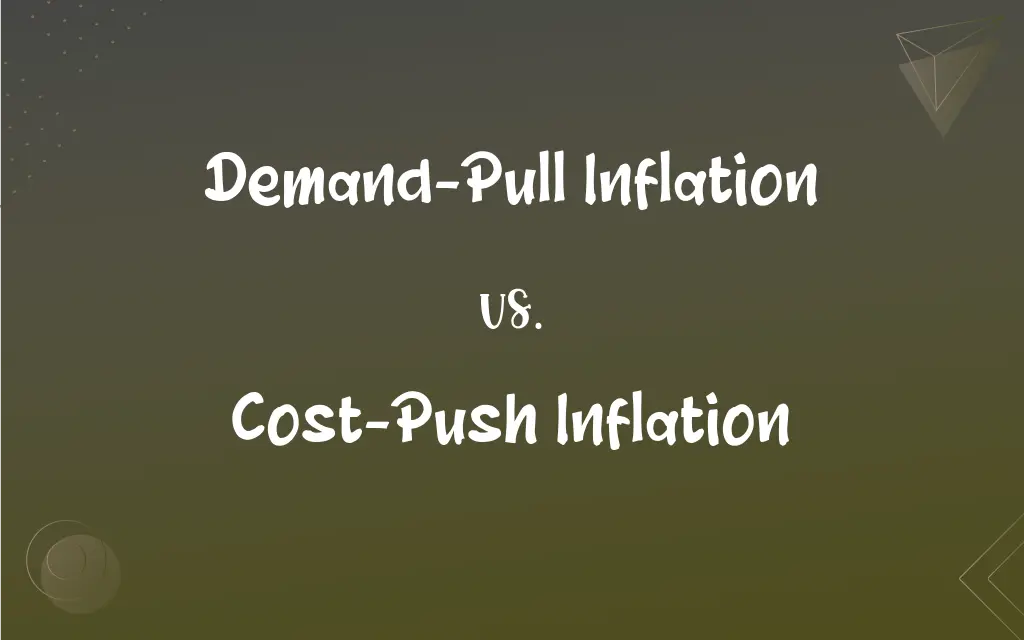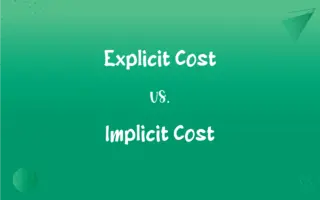Demand-Pull Inflation vs. Cost-Push Inflation: What's the Difference?
Edited by Janet White || By Harlon Moss || Updated on October 6, 2023
Demand-pull inflation occurs when demand exceeds supply, while cost-push inflation happens when costs to produce goods/services rise, elevating prices.

Key Differences
Demand-pull inflation reflects a situation where the demand for goods and services surpasses their supply, thus leading to an upward pressure on prices. Cost-push inflation, in contrast, emerges when the costs to manufacture goods or provide services, such as wages and raw materials, escalate, compelling businesses to hike prices to maintain profit margins. Both exhibit different initial triggers for price increases but achieve a similar outcome: overall higher prices within an economy.
In the context of demand-pull inflation, broad-scale economic factors such as increased consumer spending, government expenditure, or foreign investment can elevate demand beyond what an economy can currently produce. Oppositely, cost-push inflation might originate from a surge in the prices of inputs like labor or materials, or from disruptions in supply chains which elevate production costs, obliging businesses to elevate prices even if demand remains constant.
To mitigate demand-pull inflation, governments and central banks might implement policies aimed at curbing demand, like raising interest rates or decreasing government spending. When faced with cost-push inflation, the policy response might be less straightforward since reducing demand might further suppress economic activity. Thus, strategies like aiding affected industries or implementing targeted subsidies might be adopted to cushion the impact of rising costs without squelching demand.
An interesting intersection between demand-pull and cost-push inflation can occur when elevated demand leads to heightened production, which can then stimulate increased wages. This scenario would present an amalgamation of the two inflation types, where heightened demand indirectly causes an ascent in costs that subsequently further fuel inflation. Thus, managing economic balance requires understanding and navigating both demand-pull and cost-push mechanisms to ensure stability.
The global economic landscape provides numerous instances where demand-pull and cost-push inflation have materialized, sometimes concurrently. The 2020s have showcased scenarios where stimulus measures (propelling demand) and supply chain disruptions (escalating costs) have coexisted, rendering the navigation of inflationary pressures a complex task for policymakers and revealing the multifaceted interplay between demand-pull and cost-push inflation.
ADVERTISEMENT
Comparison Chart
Cause
Excess demand over supply.
Rising costs of production inputs.
Policy Response
Likely to raise interest rates to curb demand.
Might implement subsidies or aid for affected industries.
Example Scenario
Economic boom elevating consumer spending.
Surge in oil prices elevating production costs.
Impact on Output
Can potentially boost production and employment.
May reduce output and employment if costs are too high.
Long-term Impact
Might lead to overheating if unaddressed.
Can result in stagflation if accompanied by reduced demand.
ADVERTISEMENT
Demand-Pull Inflation and Cost-Push Inflation Definitions
Demand-Pull Inflation
Demand-pull inflation is typified by a condition in which soaring demand persistently nudges the price levels of goods and services upwards.
A celebrity endorsement unexpectedly skyrocketed the demand for the new sneaker line, instigating demand-pull inflation within the athletic wear market.
Cost-Push Inflation
Cost-push inflation is characterized by upward price movements stemming from a surge in the costs associated with producing goods or services.
The hurricane disrupted crop production, causing cost-push inflation by amplifying the prices of agricultural goods.
Demand-Pull Inflation
Demand-pull inflation is the uptick in price levels caused by an imbalance where aggregate demand outstrips aggregate supply.
The government’s significant infrastructure spending accelerated demand-pull inflation by drastically elevating demand for construction materials.
Cost-Push Inflation
It denotes a situation where the prices of goods and services inflate because of an increase in the cost of materials or labor.
A strike among miners led to cost-push inflation in the jewelry industry by driving up the prices of precious metals.
Demand-Pull Inflation
Demand-pull inflation represents a scenario where burgeoning demand for goods and services induces a general rise in price levels across an economy.
The tech boom prompted demand-pull inflation by fostering a voracious appetite for electronic goods amid limited supply.
Cost-Push Inflation
It unfolds when businesses respond to increased production costs by elevating the prices of their goods and services.
The new tariffs imposed on steel imports ushered in cost-push inflation, forcing car manufacturers to charge more for vehicles.
Demand-Pull Inflation
It can be a consequence of robust economic growth where the collective demand from consumers, businesses, and government exceeds available supply.
The burgeoning real estate market in the city was a classic instance of demand-pull inflation, with available units being far outstripped by demand.
Cost-Push Inflation
Cost-push inflation emerges when external factors, like supply chain disruptions or input scarcities, inflate production costs and subsequently, product prices.
Global supply chain issues triggered cost-push inflation in the electronics industry by limiting the availability and elevating the cost of semiconductors.
Demand-Pull Inflation
It transpires when enhanced consumer spending, investment, and governmental expenditure collectively elevate overall demand, leading to higher prices.
The holiday season often witnesses demand-pull inflation as consumers’ elevated purchasing propels the prices of popular goods upward.
Cost-Push Inflation
Cost-push inflation arises when the overall price levels increase due to the elevated costs of production inputs.
The sudden spike in crude oil prices instigated cost-push inflation, as manufacturers faced higher operational costs.
FAQs
How can central banks respond to demand-pull inflation?
By implementing policies to curtail demand, such as raising interest rates.
Can demand-pull inflation be beneficial?
It can indicate healthy economic activity but may lead to overheating if prolonged.
Can reduced governmental spending curtail demand-pull inflation?
Potentially, as it might temper overall demand in the economy.
What initiates demand-pull inflation?
An excess of overall demand over supply in the economy.
What might governments do to alleviate cost-push inflation?
Potentially offer subsidies or support to impacted industries.
What is a potential social consequence of demand-pull inflation?
Wealth disparities may widen if asset prices inflate significantly.
How might businesses adapt to persistent cost-push inflation?
By innovating, cost-cutting, adjusting prices, or shifting production approaches.
How is cost-push inflation typically triggered?
By the rise in costs of production inputs, like labor or materials.
Can cost-push inflation be global in nature?
Yes, especially if it involves widely-used commodities like oil.
Can technology advancements mitigate cost-push inflation?
Potentially, by offering more efficient or cost-effective production methods.
Can demand-pull inflation coexist with economic growth?
Yes, it often arises during periods of robust economic expansion.
In what scenarios might cost-push inflation be particularly harmful?
During economic downturns, where rising costs compound existing challenges.
Is cost-push inflation likely to lead to stagflation?
Yes, especially if high costs coincide with reduced demand and increased unemployment.
What role does consumer confidence play in demand-pull inflation?
High consumer confidence can elevate spending, potentially contributing to demand-pull inflation.
How do supply chain disruptions relate to cost-push inflation?
They can elevate production costs, driving up prices even if demand remains stable.
Can demand-pull inflation affect all sectors uniformly?
No, its impact can vary depending on the specific demand dynamics per sector.
Can global events like geopolitical conflicts induce cost-push inflation?
Absolutely, by disrupting supply chains and escalating production costs.
Is cost-push inflation inherently negative for an economy?
It is often unwelcome as it tends to decrease purchasing power without boosting output.
Is demand-pull inflation more prevalent in booming economies?
Often yes, as prosperity generally elevates aggregate demand.
How does investment impact demand-pull inflation?
Increased investment can amplify demand, potentially fueling demand-pull inflation.
About Author
Written by
Harlon MossHarlon is a seasoned quality moderator and accomplished content writer for Difference Wiki. An alumnus of the prestigious University of California, he earned his degree in Computer Science. Leveraging his academic background, Harlon brings a meticulous and informed perspective to his work, ensuring content accuracy and excellence.
Edited by
Janet WhiteJanet White has been an esteemed writer and blogger for Difference Wiki. Holding a Master's degree in Science and Medical Journalism from the prestigious Boston University, she has consistently demonstrated her expertise and passion for her field. When she's not immersed in her work, Janet relishes her time exercising, delving into a good book, and cherishing moments with friends and family.































































